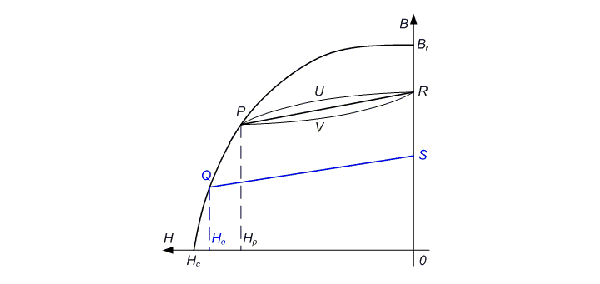Recoil Lines
The relationship between the magnetic flux density and the magnetic field intensity represented by the demagnetization curve only exists when the magnetic field intensity varies in the same direction. In fact, when the permanent magnet electric machine is working, the demagnetization field intensity varies repeatedly in both directions. When demagnetization field is applied to the magnetized permanent magnet, the magnetic flux density decreases along the curved segment BrP on the demagnetization curve as shown in the figure:

If the external demagnetization field intensity Hp is removed when the magnetic flux density reaches the point P, the magnetic flux density will increase not along the original demagnetization curve, but along another curve PVR. If the external demagnetization field intensity is reapplied, the magnetic flux density will decrease along the new curve RUP. By repeatedly applying the demagnetization field intensity, a localized loop is formed and is termed local hysteresis loop. On the local hysteresis loop, the rising segment and the dropping segment are quite close to each other, therefore can be approximated by the straight line PR, which is termed recoil line with P as the starting point. If demagnetization field with intensity Hq not exceeding the original value Hp is applied thereafter, the magnetic flux density will vary reversibly along the recoil line PR. If Hq > Hp, the magnetic flux density drops to a new starting point Q. It will vary along the new recoil line QS, but not the previous one PR. This sort of irreversible variation in magnetic flux density causes instability in the characteristics of electric machines and complicates the design computation of permanent magnet electric machines, therefore should be avoided as possible.
